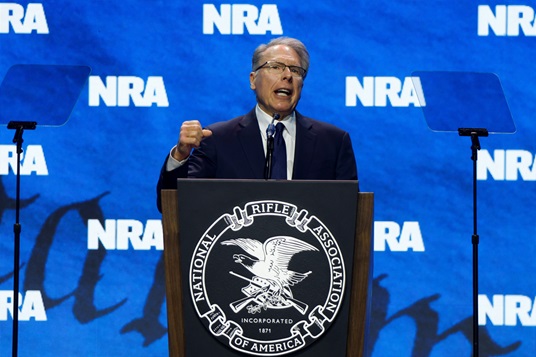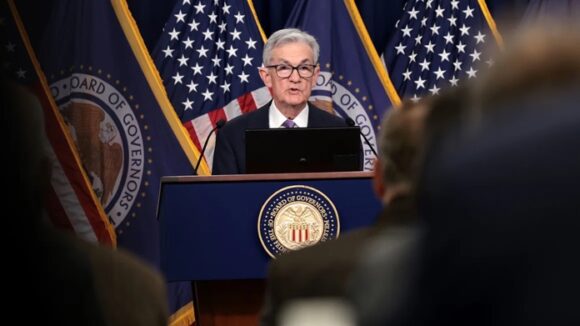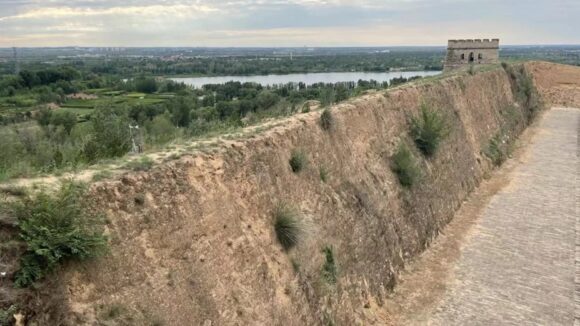 Wayne LaPierre. Credit. Evelyn Hockstein – Reuters.
Wayne LaPierre. Credit. Evelyn Hockstein – Reuters.
Dear Commons Community,
Wayne LaPierre, the longtime head of the National Rifle Association said yesterday he is resigning as of January 31st, 2024, just days before the start of a civil trial over allegations he treated himself to millions of dollars in private jet flights, yacht trips, African safaris and other extravagant perks at the powerful gun rights organization’s expense.
The trial is scheduled to start this Monday in New York Attorney General Letitia James’ lawsuit against him, the NRA and two others who’ve served as executives. LaPierre was in court this week for jury selection and is expected to testify at the trial. The NRA said it will continue to fight the lawsuit, which could result in a further shakeup of its leadership and the appointment of an independent monitor to oversee its finances. As reported by The Associated Press.
“With pride in all that we have accomplished, I am announcing my resignation from the NRA,” LaPierre said in a statement released by the organization, which said he was exiting for health reasons. “I’ve been a card-carrying member of this organization for most of my adult life, and I will never stop supporting the NRA and its fight to defend Second Amendment freedom. My passion for our cause burns as deeply as ever.”
James, a Democrat, heralded LaPierre’s resignation as an “important victory in our case” and confirmed the trial will go on as scheduled. His exit “validates our claims against him, but it will not insulate him or the NRA from accountability,” James said in a statement.
Andrew Arulanandam, a top NRA lieutenant who has served as LaPierre’s spokesperson, will assume his roles on an interim basis, the organization said.
LaPierre, 74, has led the NRA ’s day-to-day operations since 1991, acting as the face and vehement voice of its gun-rights agenda and becoming one of the most influential figures in shaping U.S. gun policy. He once warned of “jack-booted government thugs” seizing guns, brought in movie star Charlton Heston to serve as the organization’s president, and condemned gun control advocates as “opportunists” who “exploit tragedy for gain.”
In one example of the NRA’s evolution under LaPierre, after the Columbine High School shooting in Littleton, Colorado, in 1998, the NRA signaled support for expanded background checks for gun purchases. But after a gunman killed 26 people at Sandy Hook Elementary School in Newtown, Connecticut, in 2012, LaPierre repudiated background checks and called for armed guards in every school. He blamed video games, lawmakers and the media for the carnage, remarking: “The only thing that stops a bad guy with a gun is a good guy with a gun.”
“The post-Sandy Hook apocalyptic speech was kind of the talismanic moment when, for him and the NRA, there was no going back,” Robert Spitzer, a political science professor at the State University of New York-Cortland and author of several books on gun politics.
The NRA remains a strong political force, with Republican presidential hopefuls flocking to its annual convention last year. In recent years, though, the organization has been beset by financial troubles, dwindling membership, and infighting among its 76-member board along with lingering questions about LaPierre’s leadership and spending.
After reporting a $36 million deficit in 2018, fueled mostly by misspending, the NRA cut back on longstanding programs that had for decades been core to its mission, including training and education, recreational shooting and law enforcement initiatives. In 2021, the organization filed for bankruptcy and sought to incorporate in Texas instead of New York, where it was founded as a nonprofit charity in 1871 — but a judge rejected the move, saying it was a transparent attempt to duck James’ lawsuit.
“(LaPierre) is, more that any other single person, responsible for putting the NRA in the dumpster situation it is right now,” Spitzer said.
Gun control advocates lauded LaPierre’s resignation, mocking his oft-repeated talking point in the wake of myriad mass shootings over the years.
James sued LaPierre and three co-defendants — NRA general counsel John Frazer, retired finance chief Wilson Phillips and LaPierre’s ex-chief of staff Joshua Powell — in 2020, alleging they cost the organization tens of millions of dollars from questionable expenditures including lucrative consulting contracts for ex-employees, and gifts for friends and vendors.
LaPierre is accused of setting himself up with a $17 million contract with the NRA if he were to exit the organization, and spending NRA money on travel consultants, luxury car services, and private flights for himself and his family — including more than $500,000 on eight trips to the Bahamas over a three-year span.
As punishment, James is asking that LaPierre and the other defendants be ordered to pay the NRA back and that they be banned from serving in leadership positions of any charitable organizations conducting business in New York, which would bar them from any NRA involvement.
Powell, who wrote of “staggering” waste and corruption in his 2020 book “Inside the NRA,” settled with James’ office late Friday. He agreed to testify at the trial, pay the NRA $100,000 and forgo further nonprofit involvement. Frazer and Phillips have denied wrongdoing.
Defending himself in prior testimony, LaPierre said that cruising the Bahamas on a vendor’s 108-foot (33-meter) yacht was a “security retreat” because he was facing threats after the Sandy Hook and Parkland shootings. LaPierre also took steps to purchase a $6.5 million “safe house” for him and his wife in Texas through the NRA after the Parkland shooting, but the deal fell through, the lawsuit said.
LaPierre conceded not reporting the yacht trips on conflict-of-interest forms, testifying: “It’s one of the mistakes I’ve made.” Some expenses related to the trips were covered by the NRA, the lawsuit said.
Phillip Journey, an ex-NRA board member who clashed with LaPierre and is expected to testify at the New York trial, said LaPierre’s resignation doesn’t resolve open questions before the court or fix persistent rot within the organization.
“Honestly, the grifters are a snake with many heads and this is just one,” said Journey, a Kansas judge who is running to rejoin the NRA board.
Journey also testified at the NRA’s bankruptcy trial in Texas and said he anticipates there is enough evidence for the James to prove her case. “It’s a tragic end to a career that had many high points,” Journey said of LaPierre stepping down. “It’s one of his own making.”
Good riddance to LaPierre!
Tony
 ‘Utter Disgrace’: Trump Slammed After Admitting He Hopes Economy Crashes This Year. Ed Mazza- The Huffington Post.
‘Utter Disgrace’: Trump Slammed After Admitting He Hopes Economy Crashes This Year. Ed Mazza- The Huffington Post.











